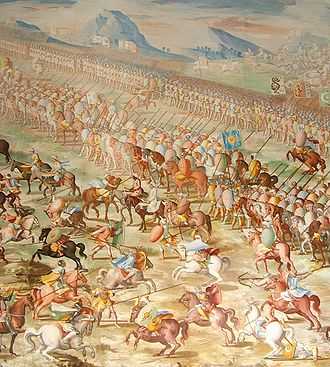Jinete

In Spanish, jinete means "horseman", and in some cases the horse, the rider or both. Originally, it meant a type of light cavalryman, proficient at skirmishing and rapid maneuver.
Origins
The word Jinete (of Berber zenata) designates, in Castilian, Catalan, Basque, Galician and the Provençal dialect of Occitan language, those who show great skill and riding especially if this relates to their work. In Portuguese, it is spelled ginete.
The Zenata were a confederation of Berber tribes during the Middle Ages, that were a rival of the Senhaja. They arose ethnically in Tunisia and eastern Algeria, prior to the invasion of the Arabs. The invasion would have forced them, among other things, to adopt as part of their tactics the use, of camels with great dexterity. Their skills were enhanced when they were able to mount a horse, especially the kind of agile horse called a light Arabian, the ancestor of the medieval European jennet. This allowed them to prevail in North Africa and this type of fighting was introduced into Spain when it was conquered by the Moors. These light horse tactics were then adopted by the Spanish during the Reconquista of the Iberian peninsula.
Military history
As a military term, jinete (also spelled ginete or genitour) means a Spanish light horseman armed with a javelin, sword and a shield, a troop type developed in the early Middle Ages in response to the massed light cavalry of the Moors.[1] Often fielded in significant numbers by the Spanish, and at times the most numerous of the Spanish mounted troops, they played an important role in Spanish mounted warfare throughout the Reconquista until the sixteenth century. They were to serve successfully in the Italian Wars under Gonzalo de Cordoba and Ramon de Cardona.
Tactics
Sir Charles Oman describes their tactics thus :
Their tactics were not to close but to hover round their opponents, continually harassing them till they should give ground or break their formation, when a chance would occur of pushing a charge home[2]
The tactics of the genitours were to swarm around the enemy, to overwhelm him with darts, to draw off if he charged in mass, but to hang upon his flanks and charge him when he grew tired, or fell into disorder[3]
In addition, Philippe Contamine records they used the tactic of feigned flight (tourna-fuye).[4]
Numbers
Jinetes existed in considerable numbers. During the period 1485-9, Castilian armies mustered between 11-13000 jinetes.[5] Some of these were provided by the Military Orders. The Master of Santiago provided 300, while the Master of Calatrava was responsible for a further 450.[6] In May 1493, a number of standing companies were established in Castile called the guardas viejas (veteran guard). These included five captaincies of 100 jinetes.[7] In 1496, the guardas reales (royal guard) of Castile included 130 jinetes.[8] Out of 600 cavalry in the Spanish expeditionary force to Italy in 1495, 500 were jinetes.[9]
Contemporary usage
In Mexico, jinete means "rodeo rider", hence "cowboy".
In Castilian, it is used adjectivally of a rider who knows how to ride a horse, especially those who are fluent or champions at equestrian practices, such as the gaucho, the huaso of the plains, the cowboy, Vaquero, or charro among others. Also used in the Spanish Army to designate personnel belonging to the cavalry arm.
In literature
In its original Spanish title "The Four Horsemen of the Apocalypse" by Vicente Blasco Ibanez is "Los Cuatro Jinetes del Apocalipsis". Canción de jinete is a poem by Federico García Lorca.[10] The novel El jinete polaco by Antonio Muñoz Molina was published in 1991.[11]
See also
References
- ↑ Contamine, Philippe (1984). War in the Middle Ages. Oxford: Blackwell. p. 58. ISBN 0-631-13142-6.
- ↑ Oman, Charles (1991) [1924]. A History of the Art of War in the Middle Ages. Vol.II 1278-1485. London: Greenhill. p. 180. ISBN 1-85367-105-3.
- ↑ Oman, Charles (1987) [1937]. A History of the Art of War in the Sixteenth Century. London: Greenhill. p. 51. ISBN 0-947898-69-7.
- ↑ Contamine (1984), p.58
- ↑ Contamine (1984), p.135
- ↑ Contamine (1984), p.163)
- ↑ Contamine (1984), p. 172
- ↑ Contamine (1984), p. 167
- ↑ Oman (1987), p. 52
- ↑ César García Alvarez (1977). Canción de jinete (in Spanish). Revista Chilena de Literatura (9/10 ): 171-178. (subscription required)
- ↑ Elizabeth Amann (Autumn 1998). Genres in Dialogue: Antonio Muñoz Molina's El jinete polaco (in Spanish). Revista Canadiense de Estudios Hispánicos 23 (1): 1-21.(subscription required)